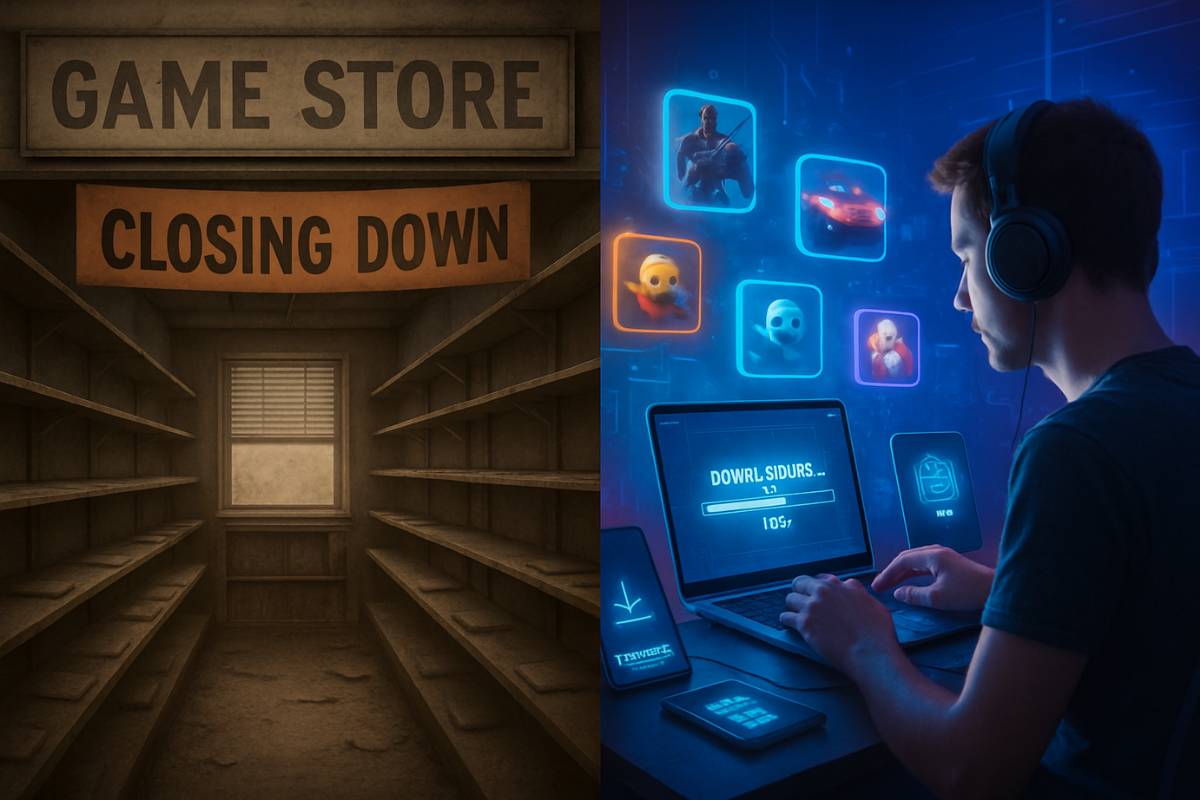The gaming industry is at a turning point. Gamers used to wait in line at midnight for the release of physical games, but that time seems to be passing quickly. According to some reports, 83% of console games were sold digitally in 2023, meaning that digital downloads now make up the vast majority of game sales. What does this change mean for the future of gaming, though, and is it permanent?
The Data Tell the Tale
Digital is clearly winning, according to the statistics. According to Sony, in the first quarter of 2022, 80% of game sales were digital. Compared to just 226 physical copies, nearly 2,200 distinct console titles were available on digital storefronts in the US by 2021.
That’s a pretty big difference, to be honest.
This is where things start to get interesting, though. Revenue from physical games is expected to drop from $8 billion in 2023 to $6 billion in 2024 and 2025. In the meantime, add-on content is expected to reach $19 billion in 2025, up from $15 billion in 2023, while digital full-game segments are steady at $8 billion annually.
The story of the mobile gaming industry is even more dramatic. Digital-only gaming has become the standard for a whole generation, with:
- 49.6 billion downloads in 2024
- Mobile market predicted to grow to almost $140 billion by 2026
The Death Spiral of Physical Retail
Do you recall the days when GameStop was ubiquitous? At one point, the well-known retailer had over 6,000 locations across the globe. Today? Only 2,300 of their locations remain, and they intend to close a “significant number” more in 2025.
In 2024 alone, the company closed almost 600 locations in the US. And it’s not just GameStop. As foot traffic declines and consumers embrace digital downloads, game retailers in North America and Europe are closing their locations.
“GameStop’s core business is in jeopardy,” stated Neil Saunders of GlobalData, who pointed out that players are increasingly choosing digital platforms such as:
- Xbox Store
- PlayStation Store
- Steam
In the UK, even well-known retailers like Game have closed the majority of their standalone locations and are now primarily concessions inside larger stores.
In Europe, where the market for physical games has fallen 22% in recent years, the change is especially noticeable. Early 2025 saw a 30% decline in boxed game sales in the UK, which was a bad sign for traditional retail.
The Benefit of Digital
Convenience Factors
Why are players switching? The most important factor is convenience. Instant access is provided by digital downloads, eliminating the need for shipping or in-store visits. Before a game is released, players can preload it to start playing as soon as launch day comes.
The space factor is another. No more jumbled game case shelves. Any connected device can access digital libraries that reside in the cloud.
Publisher Benefits
The benefits to publishers are strong:
- No expenses for production, packaging, or shipping
- Increased profit margins due to the elimination of retail middlemen
These trends were sharply accelerated by the pandemic. With 91% of the industry’s revenue derived from digital sources, lockdowns in 2020 caused digital game sales to surpass physical for the first time. This covers mobile gaming, in-app purchases, and full downloads, but the warning signs were there all along.
Here, mobile gaming is particularly noteworthy. A whole generation was conditioned to expect digital-only experiences because smartphones never supported physical games. Mobile gaming normalized digital distribution across all platforms as it spread beyond enthusiast circles to casual players looking for entertainment and community.
The Question of Ownership
There’s a catch, though. You own a tangible item when playing physical games, such as a disc or cartridge, which you can keep even if servers go down. Purchases made digitally? In actuality, you are purchasing a license to play the game.
Platforms and publishers manage that access. They have the option to revoke it in the event of:
- Server shutdowns
- Delisting
- Policy changes
That firmly places power in the hands of corporations rather than players.
Concerns regarding actual game ownership have been raised by this “rent for life” scenario, as some refer to it. Digital games are dependent on platform owners, unlike physical copies that can be exchanged, resold, or saved for nostalgia. Customers lose a game forever if a digital store decides to remove it.
This division is aptly demonstrated by the resale market. Players can trade physical games, and they retain their resale value. Customers become frustrated because digital storefronts frequently have strict refund policies and prohibit the resale of digital titles.
Market Share and Platform Wars
These digital trends are reflected in the console landscape. As of 2024, market share breaks down as follows:
- Sony’s PlayStation: 45%
- Microsoft’s Xbox: 27%
- Nintendo’s Switch: 24%
These numbers show changing ecosystems centered on digital services in addition to hardware sales.
Access to content has changed as a result of subscription services like Xbox Game Pass and PlayStation Plus. Players pay monthly fees to access large libraries rather than making individual purchases. This model offers perceived value through variety while further separating customers from conventional ownership concepts.
Nintendo offers a compelling counterargument. In Europe, about 80% of switch games are still physical. Because of this, Nintendo’s possible strategy for the Switch 2 is especially important. According to reports, they may lower the price of digital versions compared to physical copies in order to hasten the digital transition.
Environmental Aspects
Carbon Footprint Comparison
This debate is further complicated by the environmental impact. Compared to digital downloads, which only produce 0.17 kilograms of carbon emissions through electricity use, physical games produce 23 times more carbon emissions.
Getting physical games into stores generates even more carbon emissions than the emissions from production. Digital downloads eliminate the environmental costs associated with:
- Shipping companies
- Warehouse facilities
- Consumer trips to retail locations
Energy Consumption Concerns
The picture isn’t totally clear-cut, though. Data centers, which use enormous amounts of energy, are essential to cloud gaming and digital distribution. Emissions from the video game industry could reach 1.5 billion tonnes of CO2 between 2020 and 2030 if cloud gaming keeps expanding at its current rate.
The data requirements and resolution are also important. Compared to 2GB without 4K, 10 minutes of 4K gaming uses 3GB of data. With millions of players globally, this translates to massive energy usage.
Preservation Difficulties
As the industry moves toward digitalization, game preservation has emerged as a crucial issue. Cartridges and discs can last for decades if stored properly, so physical media offers a safety net for preservation. The challenges faced by digital games are different.
Digital-only titles may be permanently lost when online services shut down. Since 2008, the Centre for Computing History has conserved more than 13,000 physical video games; however, different methods are needed for digital preservation. Since emulation frequently offers the only way to access older digital titles on new hardware, source code preservation becomes crucial.
Some publishers and developers are reluctant to donate materials, which makes it difficult for organizations like the National Videogame Museum to preserve the history of gaming. Many digital games run the risk of being lost forever if preservation efforts are not actively pursued.
Regional Differences
Globally, the shift to digital is not consistent. Most markets saw a 6% year-over-year drop in downloads, but Saudi Arabia and Indonesia saw growth. Emerging markets exhibit distinct trends, with local publishers predominating in nations such as South Korea, Japan, and China.
Regional Growth Patterns
Regional differences in revenue growth are substantial:
- Turkey: 28% year-over-year growth
- Mexico: 21% growth
- India: 17% growth
- Thailand: 16% growth
- Saudi Arabia: 14% growth
As the world’s internet infrastructure advances, these emerging markets could become areas of growth.
Despite a 7% decline in downloads, the US market saw 9% revenue growth, indicating higher-value purchases. The 7% year-over-year decline in the Japanese market suggests varying regional tastes and levels of market maturity.
Economics of Industry
Revenue Trends
Digital distribution is strongly favored by the financial incentives. Add-on content revenue jumped from $15 billion in 2023 to a projected $19 billion in 2025, outpacing base game sales. This model is made possible by digital storefronts, which make it simpler to process payments and deliver content.
Additionally, subscription services are expected to grow steadily:
- 2023: $10 billion
- 2024-2025: $11 billion each year
One-time physical sales cannot compare to the stability offered by this recurring revenue model.
Mobile Gaming Concerns
But there are some issues with the mobile gaming industry. Downloads decreased 6% to 49.6 billion in 2024, despite revenue increasing 4% to $80.9 billion. This implies that some markets are saturated and that there is a growing emphasis on making money off of current players rather than acquiring new ones.
The Dilemma of the Collector
The future of physical game collectors is uncertain. Special editions and limited-edition businesses continue to attract customers, but mainstream physical releases are dwindling. Physical game releases in Germany continued to decline through 2025, and this trend is predicted to continue.
Value Beyond Gaming
Beyond just game access, physical media has real value for collectors:
- Cover art and packaging design
- Instruction manuals
- Emotional connections to tangible items
- Resale market opportunities
Digital libraries are unable to replicate these emotional connections. Additionally, the resale market offers financial advantages that digital purchases do not.
Platform-Specific Trends
Certain platforms and genres continue to have a more noticeable physical presence:
- AAA action platformers for Switch
- Single-player survival horror games for PlayStation
- Certain sports titles
However, Xbox and PC multiplayer shooters have mostly given up on physical distribution.
Prospects for the Future
According to industry experts, digital games will completely take over in less than ten years. This prediction is supported by the trends, which include a decline in physical retail, an increase in digital infrastructure, and shifting consumer behavior.
But there are still difficulties. In the first nine months of recent reporting periods, 32 million physical games were still sold throughout Europe, indicating that the boxing market “remains a viable opportunity.” It’s possible that the industry isn’t quite prepared to give up on physical distribution.
Hardware Strategy Changes
Manufacturers of hardware are changing their approaches. Platform holders may hasten the shift, as evidenced by reports that Nintendo may price Switch 2 digital games lower than physical versions. This strategy might give many consumers the last push they need to completely give up on physical media.
Cloud services and cross-platform gaming keep changing the game. The distinctions between various gaming ecosystems are becoming less clear as games are made available on console, PC, and mobile platforms. Digital distribution models that function flawlessly across devices are further supported by this convergence.
Implications for Gamers
Benefits and Drawbacks
The change has both positive and negative effects on individual players:
Advantages:
- Convenience and instant access
- Space savings in homes
- Digital sales and promotional pricing
Disadvantages:
- Loss of resale value
- Platform dependency
- Long-term access concerns
Many modern lifestyles are attracted to convenience, instant access, and space savings. Although physical games frequently see larger discounts over time, digital sales and promotional pricing can provide good value.
Economic Impact
For gamers on a tight budget, the loss of resale value has a substantial financial impact. With digital libraries, friends can no longer trade, sell, or borrow physical games. Some players believe they’re losing more than they’re gaining, especially when combined with worries about platform control and long-term access.
Broader Media Trends
The move to digital gaming reflects broader shifts in media consumption. Books, movies, and music have all gone the same way, with digital downloads and streaming taking the place of physical media. Simply put, the gaming industry is the most recent to make this shift, despite particular difficulties with ownership and preservation.
Physical gaming hasn’t completely died yet. Certain game types, collectors, and niche markets will probably continue to have some physical presence. However, it appears that the writing is on the wall for popular gaming. Not only has digital distribution benefited from better economics, but it has also radically altered our perception of games as experiences to be accessed rather than as possessions.
Perspective plays a major role in determining whether that is progress or loss. However, there is no doubt that the gaming scene of the future will differ greatly from the packed game stores and midnight launch lines of the past.
















